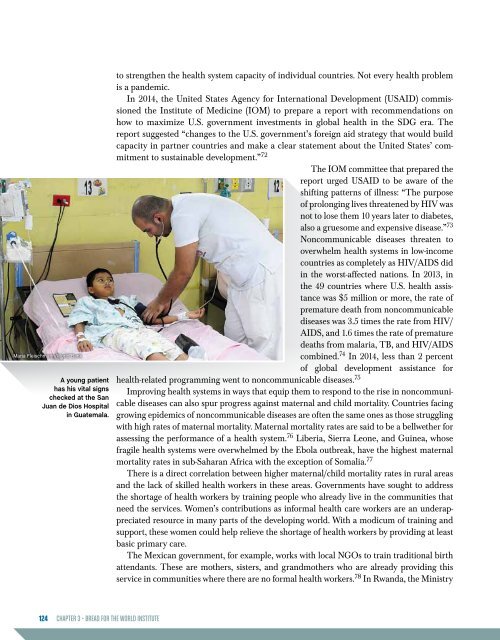THE NOURISHING EFFECT
HR2016-Full-Report-Web
HR2016-Full-Report-Web
Create successful ePaper yourself
Turn your PDF publications into a flip-book with our unique Google optimized e-Paper software.
Maria Fleischmann/World Bank<br />
A young patient<br />
has his vital signs<br />
checked at the San<br />
Juan de Dios Hospital<br />
in Guatemala.<br />
to strengthen the health system capacity of individual countries. Not every health problem<br />
is a pandemic.<br />
In 2014, the United States Agency for International Development (USAID) commissioned<br />
the Institute of Medicine (IOM) to prepare a report with recommendations on<br />
how to maximize U.S. government investments in global health in the SDG era. The<br />
report suggested “changes to the U.S. government’s foreign aid strategy that would build<br />
capacity in partner countries and make a clear statement about the United States’ commitment<br />
to sustainable development.” 72<br />
The IOM committee that prepared the<br />
report urged USAID to be aware of the<br />
shifting patterns of illness: “The purpose<br />
of prolonging lives threatened by HIV was<br />
not to lose them 10 years later to diabetes,<br />
also a gruesome and expensive disease.” 73<br />
Noncommunicable diseases threaten to<br />
overwhelm health systems in low-income<br />
countries as completely as HIV/AIDS did<br />
in the worst-affected nations. In 2013, in<br />
the 49 countries where U.S. health assistance<br />
was $5 million or more, the rate of<br />
premature death from noncommunicable<br />
diseases was 3.5 times the rate from HIV/<br />
AIDS, and 1.6 times the rate of premature<br />
deaths from malaria, TB, and HIV/AIDS<br />
combined. 74 In 2014, less than 2 percent<br />
of global development assistance for<br />
health-related programming went to noncommunicable diseases. 75<br />
Improving health systems in ways that equip them to respond to the rise in noncommunicable<br />
diseases can also spur progress against maternal and child mortality. Countries facing<br />
growing epidemics of noncommunicable diseases are often the same ones as those struggling<br />
with high rates of maternal mortality. Maternal mortality rates are said to be a bellwether for<br />
assessing the performance of a health system. 76 Liberia, Sierra Leone, and Guinea, whose<br />
fragile health systems were overwhelmed by the Ebola outbreak, have the highest maternal<br />
mortality rates in sub-Saharan Africa with the exception of Somalia. 77<br />
There is a direct correlation between higher maternal/child mortality rates in rural areas<br />
and the lack of skilled health workers in these areas. Governments have sought to address<br />
the shortage of health workers by training people who already live in the communities that<br />
need the services. Women’s contributions as informal health care workers are an underappreciated<br />
resource in many parts of the developing world. With a modicum of training and<br />
support, these women could help relieve the shortage of health workers by providing at least<br />
basic primary care.<br />
The Mexican government, for example, works with local NGOs to train traditional birth<br />
attendants. These are mothers, sisters, and grandmothers who are already providing this<br />
service in communities where there are no formal health workers. 78 In Rwanda, the Ministry<br />
124 CHAPTER 3 • BREAD FOR <strong>THE</strong> WORLD INSTITUTE


